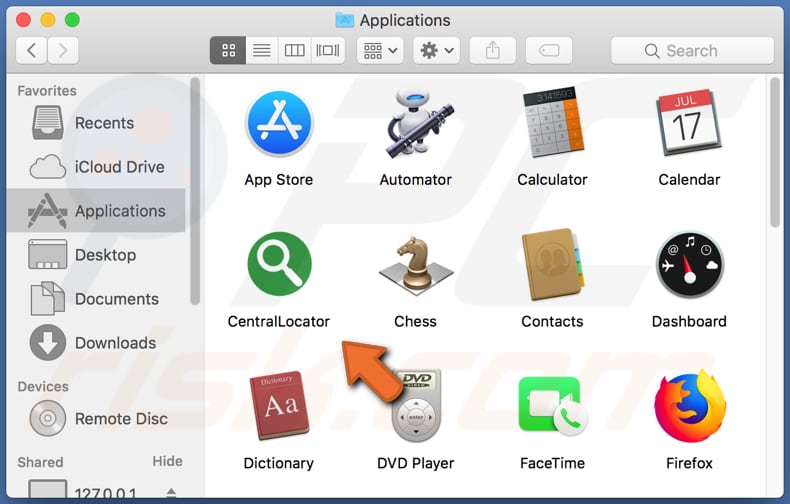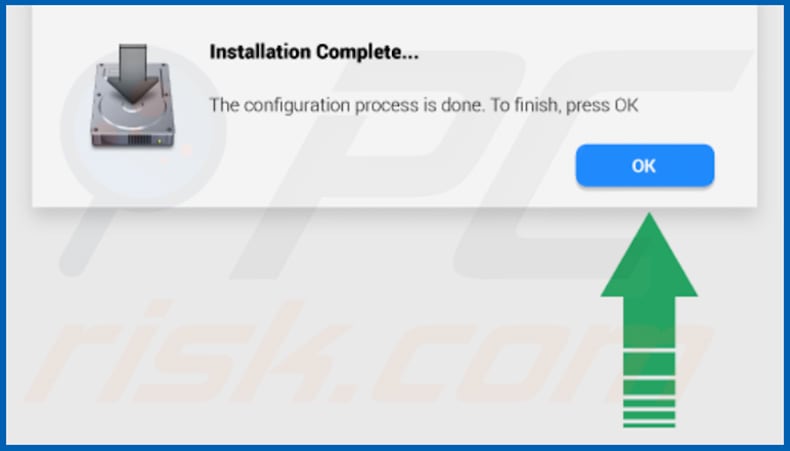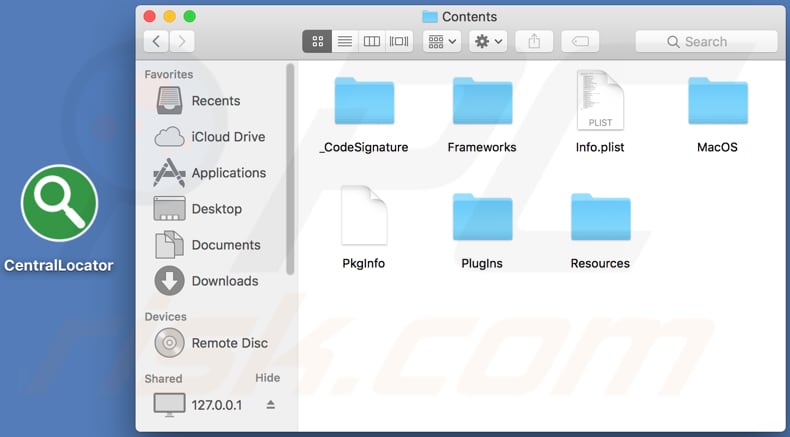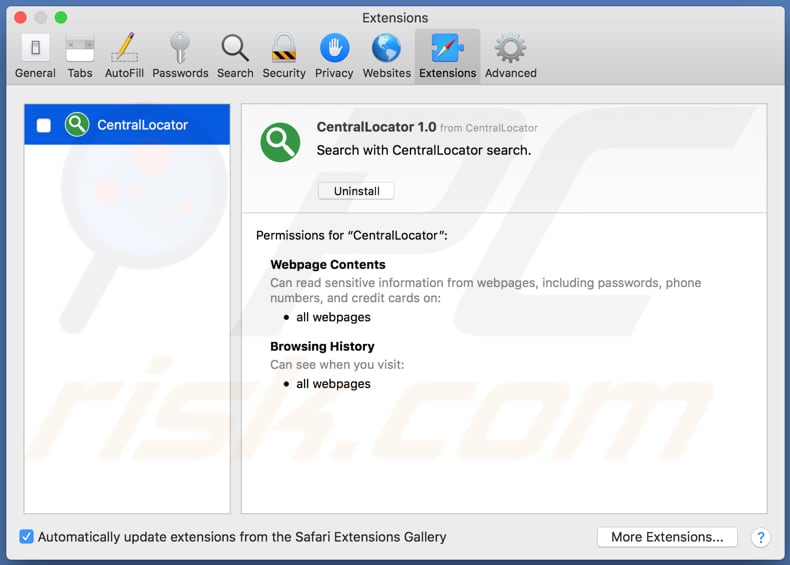Get free scan and check if your device is infected.
Remove it nowTo use full-featured product, you have to purchase a license for Combo Cleaner. Seven days free trial available. Combo Cleaner is owned and operated by RCS LT, the parent company of PCRisk.com.
What is CentralLocator?
CentralLocator is the name of a potentially unwanted application (PUA) that is categorized as adware. This program supposedly enhances the browsing experience, however, it serves intrusive advertisements and gathers various information. Adware-type apps are termed 'PUAs', since people usually do not download or install them intentionally.

Generally, apps such as CentralLocator (adware) serve advertisements that lead to untrustworthy websites. Some of these ads execute scripts that cause download/installation of other unwanted programs. Examples ads displayed by adware-type applications include pop-ups, coupons, banners and surveys.
These should not be trusted or clicked. Furthermore, PUAs often collect browsing-related information. For example, IP addresses, geolocations, entered search queries, addresses of visited websites, and so on. This particular app can access sensitive information as well: it can read data from websites such as passwords, telephone numbers, credit card details, etc.
Adware developers sell the data to third parties (potentially, cyber criminals) who misuse it to generate revenue. People who have CentralLocator installed on their browsers and operating systems might experience problems relating to privacy, browsing safety.
They could also become victims of identity theft, suffer monetary loss, and experience other serious issues. For these reasons, do not download or install CentralLocator. If this PUA is already installed, remove it immediately.
| Name | Ads by CentralLocator |
| Threat Type | Adware, Mac malware, Mac virus. |
| Detection Names | Avast (MacOS:Adload-AA [Trj]), AVG (MacOS:Adload-AA [Trj]), Kaspersky (Not-a-virus:HEUR:AdWare.Script.SearchExt.gen), ZoneAlarm by Check Point (Not-a-virus:HEUR:AdWare.Script.SearchExt.gen), Full List (VirusTotal) |
| Symptoms | Your Mac becomes slower than normal, you see unwanted pop-up ads, you are redirected to dubious websites. |
| Distribution methods | Deceptive pop-up ads, free software installers (bundling), fake Flash Player installers, torrent file downloads. |
| Damage | Internet browser tracking (potential privacy issues), display of unwanted ads, redirects to dubious websites, loss of private information. |
| Malware Removal (Windows) |
To eliminate possible malware infections, scan your computer with legitimate antivirus software. Our security researchers recommend using Combo Cleaner. Download Combo CleanerTo use full-featured product, you have to purchase a license for Combo Cleaner. 7 days free trial available. Combo Cleaner is owned and operated by RCS LT, the parent company of PCRisk.com. |
CentralLocator is virtually identical to many other adware-type apps including, for example, AreaProduct, CentralHere and SimpleSearchApp.
In most cases, these apps are advertised as legitimate, supposedly delivering various features. In fact, adware does not operate as promoted and simply causes problems. Most adware-type apps are designed to perform actions to help the developers to generate revenue.
How did CentralLocator install on my computer?
Typically, people download/install adware and other unwanted software (PUAs) through intrusive ads that they have clicked, or together with other (usually free) software. Developers distribute PUAs using a deceptive marketing method called "bundling". They use this technique to trick people into causing unwanted downloads and installations.
They succeed simply by hiding PUAs in "Advanced", "Custom" and other similar settings of download/installation set-ups. People often download and install PUAs inadvertently when they fail to check and change settings that are included in the set-ups.
How to avoid installation of potentially unwanted applications
To prevent unwanted apps from being downloaded and installed, we recommend that you download software (especially if it is free) only from official websites and using direct download links. Do not use third party downloaders, installers, unofficial websites, Peer-to-Peer networks or other such tools to download/install software.
Check "Custom", "Advanced" and other similar settings included in the set-ups, and decline offers to download and/or install any unwanted programs. Furthermore, to avoid unintentional downloads and installations, do not to click ads displayed on dubious web pages.
Once clicked, they usually redirect to untrustworthy websites or cause unwanted downloads and installations. If the browser is already causing redirects to dubious sites or displaying unwanted ads, it can be stopped by removing all unwanted, unknown/suspicious extensions, add-ons and plug-ins.
Also remove programs of this type from the operating system. If your computer is already infected with CentralLocator, we recommend running a scan with Combo Cleaner Antivirus for Windows to automatically eliminate this adware.
Pop-up window displayed once CentralLocator installation is complete:

Installation folder of CentralLocator adware:

CentralLocator installed on Safari:

Instant automatic malware removal:
Manual threat removal might be a lengthy and complicated process that requires advanced IT skills. Combo Cleaner is a professional automatic malware removal tool that is recommended to get rid of malware. Download it by clicking the button below:
DOWNLOAD Combo CleanerBy downloading any software listed on this website you agree to our Privacy Policy and Terms of Use. To use full-featured product, you have to purchase a license for Combo Cleaner. 7 days free trial available. Combo Cleaner is owned and operated by RCS LT, the parent company of PCRisk.com.
Quick menu:
- What is CentralLocator?
- STEP 1. Remove CentralLocator related files and folders from OSX.
- STEP 2. Remove CentralLocator ads from Safari.
- STEP 3. Remove CentralLocator adware from Google Chrome.
- STEP 4. Remove CentralLocator ads from Mozilla Firefox.
Video showing how to remove adware and browser hijackers from a Mac computer:
CentralLocator adware removal:
Remove CentralLocator-related potentially unwanted applications from your "Applications" folder:

Click the Finder icon. In the Finder window, select "Applications". In the applications folder, look for "MPlayerX", "NicePlayer", or other suspicious applications and drag them to the Trash. After removing the potentially unwanted application(s) that cause online ads, scan your Mac for any remaining unwanted components.
DOWNLOAD remover for malware infections
Combo Cleaner checks if your computer is infected with malware. To use full-featured product, you have to purchase a license for Combo Cleaner. 7 days free trial available. Combo Cleaner is owned and operated by RCS LT, the parent company of PCRisk.com.
Remove adware-related files and folders

Click the Finder icon, from the menu bar. Choose Go, and click Go to Folder...
 Check for adware generated files in the /Library/LaunchAgents/ folder:
Check for adware generated files in the /Library/LaunchAgents/ folder:

In the Go to Folder... bar, type: /Library/LaunchAgents/

In the "LaunchAgents" folder, look for any recently-added suspicious files and move them to the Trash. Examples of files generated by adware - "installmac.AppRemoval.plist", "myppes.download.plist", "mykotlerino.ltvbit.plist", "kuklorest.update.plist", etc. Adware commonly installs several files with the exact same string.
 Check for adware generated files in the ~/Library/Application Support/ folder:
Check for adware generated files in the ~/Library/Application Support/ folder:

In the Go to Folder... bar, type: ~/Library/Application Support/

In the "Application Support" folder, look for any recently-added suspicious folders. For example, "MplayerX" or "NicePlayer", and move these folders to the Trash.
 Check for adware generated files in the ~/Library/LaunchAgents/ folder:
Check for adware generated files in the ~/Library/LaunchAgents/ folder:

In the Go to Folder... bar, type: ~/Library/LaunchAgents/

In the "LaunchAgents" folder, look for any recently-added suspicious files and move them to the Trash. Examples of files generated by adware - "installmac.AppRemoval.plist", "myppes.download.plist", "mykotlerino.ltvbit.plist", "kuklorest.update.plist", etc. Adware commonly installs several files with the exact same string.
 Check for adware generated files in the /Library/LaunchDaemons/ folder:
Check for adware generated files in the /Library/LaunchDaemons/ folder:

In the "Go to Folder..." bar, type: /Library/LaunchDaemons/

In the "LaunchDaemons" folder, look for recently-added suspicious files. For example "com.aoudad.net-preferences.plist", "com.myppes.net-preferences.plist", "com.kuklorest.net-preferences.plist", "com.avickUpd.plist", etc., and move them to the Trash.
 Scan your Mac with Combo Cleaner:
Scan your Mac with Combo Cleaner:
If you have followed all the steps correctly, your Mac should be clean of infections. To ensure your system is not infected, run a scan with Combo Cleaner Antivirus. Download it HERE. After downloading the file, double click combocleaner.dmg installer. In the opened window, drag and drop the Combo Cleaner icon on top of the Applications icon. Now open your launchpad and click on the Combo Cleaner icon. Wait until Combo Cleaner updates its virus definition database and click the "Start Combo Scan" button.

Combo Cleaner will scan your Mac for malware infections. If the antivirus scan displays "no threats found" - this means that you can continue with the removal guide; otherwise, it's recommended to remove any found infections before continuing.

After removing files and folders generated by the adware, continue to remove rogue extensions from your Internet browsers.
Remove malicious extensions from Internet browsers
 Remove malicious Safari extensions:
Remove malicious Safari extensions:

Open the Safari browser, from the menu bar, select "Safari" and click "Preferences...".

In the preferences window, select "Extensions" and look for any recently-installed suspicious extensions. When located, click the "Uninstall" button next to it/them. Note that you can safely uninstall all extensions from your Safari browser - none are crucial for regular browser operation.
- If you continue to have problems with browser redirects and unwanted advertisements - Reset Safari.
 Remove malicious extensions from Google Chrome:
Remove malicious extensions from Google Chrome:

Click the Chrome menu icon ![]() (at the top right corner of Google Chrome), select "More Tools" and click "Extensions". Locate all recently-installed suspicious extensions, select these entries and click "Remove".
(at the top right corner of Google Chrome), select "More Tools" and click "Extensions". Locate all recently-installed suspicious extensions, select these entries and click "Remove".

- If you continue to have problems with browser redirects and unwanted advertisements - Reset Google Chrome.
 Remove malicious extensions from Mozilla Firefox:
Remove malicious extensions from Mozilla Firefox:

Click the Firefox menu ![]() (at the top right corner of the main window) and select "Add-ons and themes". Click "Extensions", in the opened window locate all recently-installed suspicious extensions, click on the three dots and then click "Remove".
(at the top right corner of the main window) and select "Add-ons and themes". Click "Extensions", in the opened window locate all recently-installed suspicious extensions, click on the three dots and then click "Remove".

- If you continue to have problems with browser redirects and unwanted advertisements - Reset Mozilla Firefox.
Share:

Tomas Meskauskas
Expert security researcher, professional malware analyst
I am passionate about computer security and technology. I have an experience of over 10 years working in various companies related to computer technical issue solving and Internet security. I have been working as an author and editor for pcrisk.com since 2010. Follow me on Twitter and LinkedIn to stay informed about the latest online security threats.
PCrisk security portal is brought by a company RCS LT.
Joined forces of security researchers help educate computer users about the latest online security threats. More information about the company RCS LT.
Our malware removal guides are free. However, if you want to support us you can send us a donation.
DonatePCrisk security portal is brought by a company RCS LT.
Joined forces of security researchers help educate computer users about the latest online security threats. More information about the company RCS LT.
Our malware removal guides are free. However, if you want to support us you can send us a donation.
Donate
▼ Show Discussion